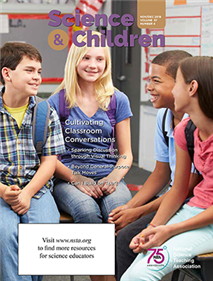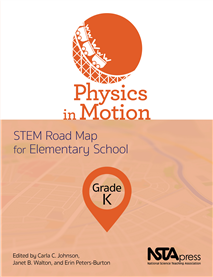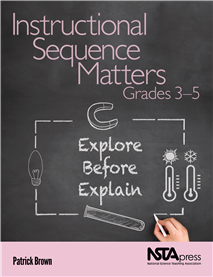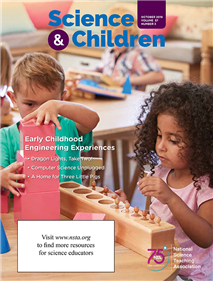All Resources
Journal
Science and Children—November/December 2019
When we listen to student conversations, we have a window into their thinking, and knowing what students think can help determine their needs and advance them toward deeper understandings. This month, we take a look at cultivating classroom conversat...
Journal
Science Scope—November/December 2019
Using technology to transform lessons into meaningful learning experiences means focusing on learning goals rather than the technology tool. Step outside of your comfort zone as you integrate technology into your classroom with the articles found in ...
Journal
The Science Teacher—November/December 2019
Volume 87, Number 4 Learning on Personal Devices Tablets, cell phones, and other handheld devices have become increasingly popular tools to help students learn. In this issue we examine innovative ways teachers have incorporated handheld de...
Journal
Journal of College Science Teaching—November/December 2019
In this issue of the Journal of College Science Teaching, learn about how a large southeastern university developed specialized science training for elementary preservice teachers. Discover how a course for first-year science majors encourages STEM p...
Journal Article
Fostering a STEAM Mindset Across Learning Settings
Developing a growth mindset has been identified as a key strategy for increasing youth achievement, motivation, and resiliency (Rattan et al. 2015). At its core, growth mindset describes the idea that one’s abilities can change through using new ...
By Laura D. Carsten Conner, Blakely K. Tsurusaki, Carrie Tzou, Perrin Teal Sullivan, Mareca Guthrie, and Stephen M. Pompea
Journal Article
Changing Mindsets Through Educator Training
MOXI, The Wolf Museum of Exploration + Innovation, is a new museum in Santa Barbara, California, designed to engage visitors of all ages in constructing understanding of STEM (science, technology, engineering, and math) topics through active engage...
By Ron Skinner, Danielle B. Harlow, and Kaia Joye Wesolowski
Journal Article
Using the ChangeMaker Mindsets™ to Enhance STEM Experiences
A ChangeMaker is anyone who chooses to take creative action to solve a problem for impact. The ChangeMaker Mindsets™ help youth navigate ambiguity and reframe thinking toward problem-solving. As students embrace and use the ChangeMaker Mind...
By Amanda Kopischke and Angela Anderson
Journal Article
What STEM Mindset Is … and Why Everyone Should Have One
A STEM (science, technology, engineering, and math) mindset encompasses many things, and perhaps does not mean the same thing to every person. Many believe, however, that it combines general attributes that are independent of an individual’s acad...
By Beth Murphy
eBook
It’s Still Debatable! Using Socioscientific Issues to Develop Scientific Literacy, K–5 (e-book)
It’s Still Debatable! encourages scientific literacy by showing you how to teach the content and thinking skills K–5 students need to explore real-world questions like these: • Is football too dangerous for kids? • Do we need zoos? �...
NSTA Press Book
It's Still Debatable! Using Socioscientific Issues to Develop Scientific Literacy, K–5
It’s Still Debatable! encourages scientific literacy by showing you how to teach the content and thinking skills K–5 students need to explore real-world questions like these: • Is football too dangerous for kids? • Do we need zoos? �...
By Sami Kahn
eBook
Physics in Motion, Grade K: STEM Road Map for Elementary School (e-book)
What if you could challenge your kindergartners to create a mini roller coaster as an entry point to understanding the physics of motion? With this volume in the STEM Road Map Curriculum Series, you can!...
eBook
Instructional Sequence Matters, Grades 3–5: Explore Before Explain (e-book)
Instructional Sequence Matters, Grades 3–5 is a one-stop resource that will inspire you to reimagine how you teach science in elementary school. The book discusses two popular approaches for structuring your lessons: POE (Predict, Observe, and Expl...
NSTA Press Book
Making Sense of Science and Religion: Strategies for the Classroom and Beyond
The authors of Making Sense of Science and Religion believe that addressing interactions between science and religion is part of all science educators’ collective job—and that this is the book that will help you facilitate discussion when the top...
By Joseph W. Shane, Lee Meadows, Ronald S. Hermann, Ian C. Binns
Journal Article
Preschool students learn about engineering through designing and testing homes. ...
By Barbara A. Bradley, Kelli Thomas, and A. Allen Bradley Jr.
Journal Article
Never Too Young to be a Citizen Scientist!
Kindergarteners learn about plants and seasons through a yearlong project. ...
By Mary Hatton, Sara Grimbilas, Caroline Kane, and Tara Kenyon
Journal Article
Teaching STEM in the Preschool Classroom
By Alissa A. Lange, Kimberly Brenneman, and Hagit Mano.
Journal Article
This column includes activities inspired by children’s literature. ...
By Christine Anne Royce
Journal Article
This column describes creating a classroom culture for engineering. ...
By Kimberly Lott, Sara Urbanek-Carney, and April Mitchell
Journal Article
This column provides ideas and techniques to enhance your science teaching. ...
By Marisa Garcia, Christine Gentry, Elissa Jordan, Bekka Nolan, and Christine M. Cunningham











